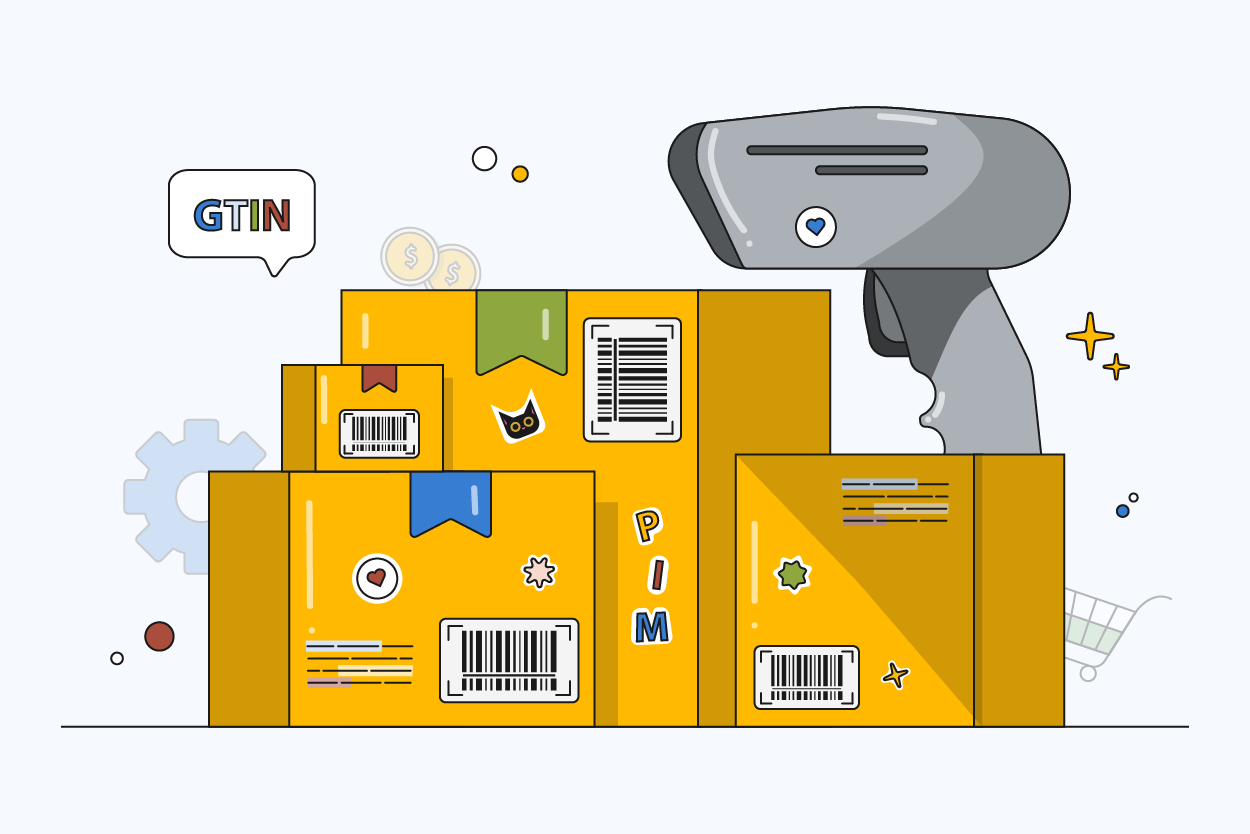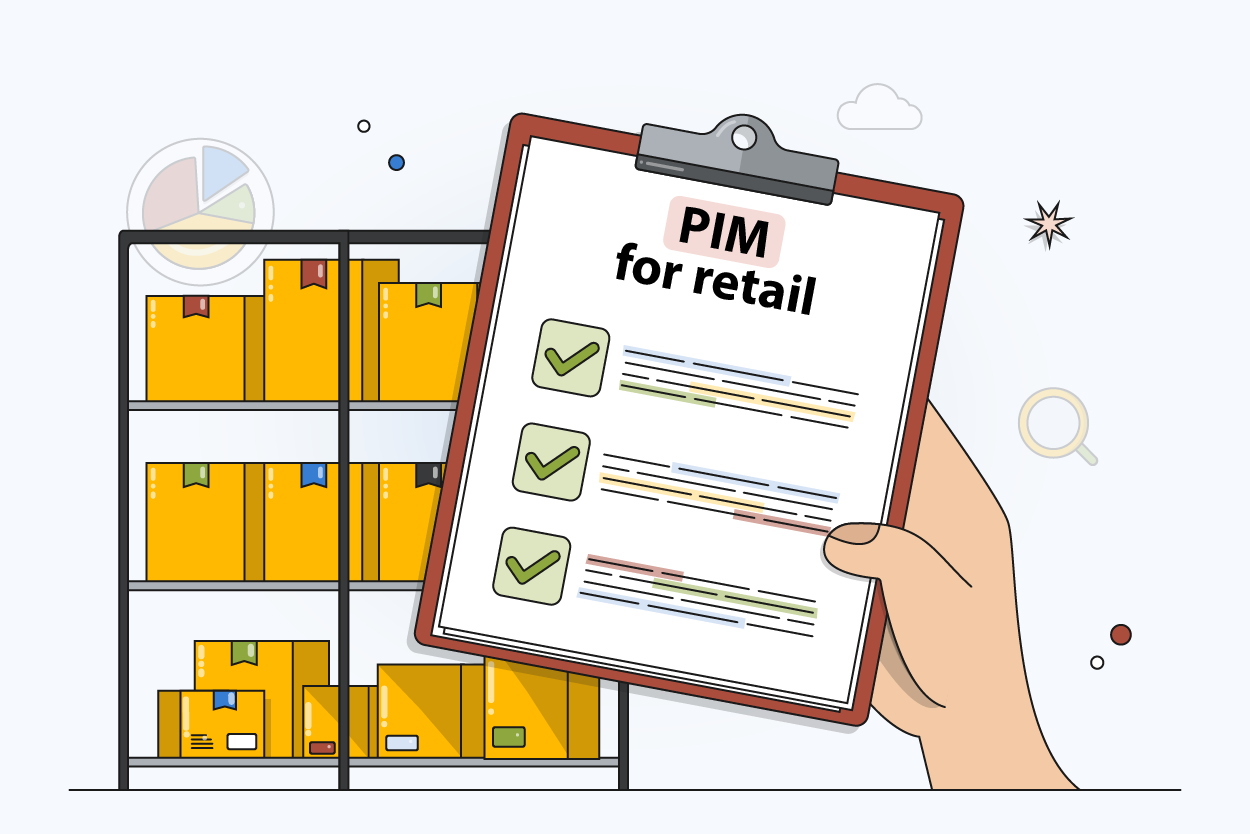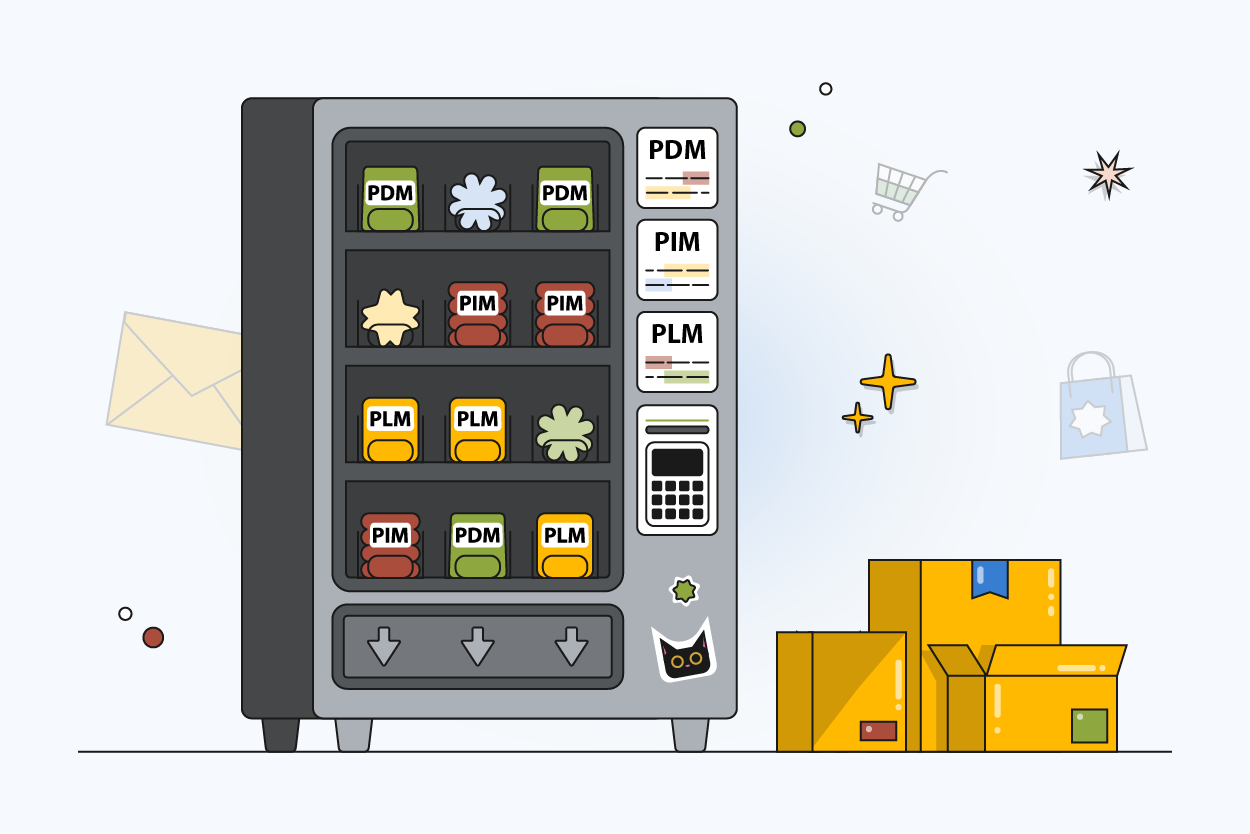What is a GTIN Number? Complete Guide for E-commerce & Retail
Author name: Mark Chickering

A GTIN (Global Trade Item Number) is a unique numeric identifier assigned to products for tracking and sales worldwide. Every barcode you scan at checkout contains a GTIN that helps retailers, manufacturers, and supply chains identify and manage products accurately.
GTINs are managed by GS1, a global standards organization, and come in several formats including 12-digit UPCs (common in North America), 13-digit EAN codes (used internationally), and 14-digit codes for wholesale packaging. Understanding GTINs is essential if you sell products online, manage inventory, or work in supply chain operations.
This guide explains how GTINs work, why they matter for your business, and how to obtain and manage them effectively.
Table of Contents:
- Understanding GTIN Numbers
- Importance of GTIN Numbers in Supply Chain
- Benefits of Using GTIN Numbers
- How to Get a UPC Barcode
- GTIN Numbers in Different Industries
- How a PIM Solution Makes GTIN Management Easier
- Case Studies on Successful Implementations of GTIN Management
- Conclusion
- FAQs in Relation to What is a Gtin Number
Understanding GTIN Numbers
A GTIN is a string of numbers (8, 12, 13, or 14 digits) that uniquely identifies a product in the global marketplace. When you scan a barcode at a store, you're reading a GTIN encoded in that barcode.
GTINs serve three critical functions:
- Product identification across all sales channels and countries
- Inventory tracking throughout the supply chain
- Accurate product data exchange between trading partners
For example, a bottle of Coca-Cola sold in New York has the same GTIN as one sold in Tokyo, allowing retailers worldwide to order, track, and sell the product using a single identifier.
Breaking Down the Structure of a GTIN
The structure of each GTIN is standardized but allows for various configurations based on factors like company size and packaging levels. Each part plays an essential role:
- Company Prefix: This section is unique to every business and forms the start of every one of their codes.
- Item Reference: Assigned by you – this portion distinguishes between your different products.
- Packaging Level Indicator: It signifies whether it’s identifying an individual item or bulk quantity.
This digit structure helps businesses track inventory accurately while providing clarity about where goods originate from - even when they're far away from home.
The Role of GS1 in GTIN Management
You might ask yourself: "Who ensures these numbers remain unique worldwide?" That responsibility falls onto GS1.
This not-for-profit organization sets standards for how companies identify their trade items across global supply chains. In fact, GS1 provides industry-wide solutions for identifying, capturing, and sharing data among trading partners—improving overall efficiency.
With over 150 national branches including GS1 US, they are indeed the gatekeepers of global trade item numbers. The work they do is fundamental to maintaining the integrity and functionality of GTINs across all sectors.
Understanding GTIN numbers means grasping their global significance in identifying trade items. They are standardized, unique codes assigned to products or services for tracking and information retrieval across the supply chain. GS1, a not-for-profit organization, ensures these numbers stay distinct worldwide while improving overall trading efficiency.
Importance of GTIN Numbers in Supply Chain
The role of GTIN numbers, or Global Trade Item Numbers, is vital to effective supply chain management. As unique identifiers for trade items worldwide, they make sure product data stays accurate and consistent among trading partners.
Using UPC Barcodes in the Supply Chain
GS1, the organization behind GTINs, also established the Universal Product Code (UPC). These barcodes are a visual representation of GTINs used extensively in retail inventory management.
A UPC barcode's primary function is encoding a 12-digit number that uniquely identifies products. The beauty lies within its simplicity - just scan it with any standard barcode reader to get all necessary information about an item instantly. This reduces human error and speeds up processes like checkout and stock-taking significantly.
Different industries have varying demands when it comes to handling their supply chains. That’s where GS1 steps into action by organizing industry initiatives for various sectors including apparel & general merchandise, retail grocery, foodservice, healthcare; this allows companies from these industries to identify their specific needs better.
Standardized identification systems like GTINs are essential for maintaining efficiency across complex global trade networks where countless products move between multiple locations daily.
- An organized system leads to more efficient distribution routes,
- Faster delivery times,
- Better customer service levels due primarily reduced errors during the order fulfillment process which translates into happier customers overall.
These factors contribute towards making supply chains agile enough to respond quickly to changing market demands while simultaneously minimizing costs wherever possible – both crucial elements in the competitive business environment today.
GTIN numbers and UPC barcodes are vital tools for efficient supply chain management. They ensure product data accuracy, speed up processes, reduce errors, and improve customer service levels. Embracing these identification systems is a must for any business seeking to navigate global trade successfully.
Benefits of Using GTIN Numbers
It's your product's passport to the global market, enhancing trust and efficiency at every step.
Efficient Supply Chain Management
A GTIN number allows for swift identification in supply chains. This unique identifier cuts through confusion, ensuring that everyone - from warehouse workers to retail cashiers - knows exactly what they're dealing with.
It also simplifies inventory management by reducing human error. After all, it’s much easier to scan a bar code than manually entering data into a system.
Better Customer Trust
When customers see products marked with recognizable UPC barcodes, their confidence goes up because they know those items have passed stringent standards set by GS1 – an organization known globally for its rigorous tracking protocols.
This assurance extends beyond consumers' homes and reaches back along the supply chain where trading partners feel more secure transacting business when equipped with reliable data carried by these UPC Barcodes or other barcode types under the umbrella term 'GTIN.'
Digital Integration Ready
In our digital era, GTIN numbers provide immense value as well. The ability to uniquely identify trade items means seamless integration into e-commerce platforms and databases across the globe – making online selling smoother while enabling accurate product information sharing amongst solution partners using Product Information Management (PIM).
GS1, responsible for allocating these digit combinations has recognized this shift towards digitalization which led them towards developing Digital Link standard transforming traditional one-dimensional GTINS into web addresses linking directly back to brand owners thus creating another layer of trust and authenticity.
Maximize Your E-commerce Performance
GTINs help customers find your products, but PIM ensures they get complete, accurate information that drives conversions across all channels.
Regulatory Compliance
Moreover, many industries like healthcare now require GTIN usage for regulatory compliance. It’s become a de facto standard for traceability in sectors dealing with sensitive goods – from fresh foods to pharmaceuticals.
GTIN numbers are more than just digits; they're a passport to global markets, boosting trust and efficiency. They help streamline supply chains, build customer confidence with recognizable barcodes, and integrate smoothly into digital platforms for easy e-commerce transactions. Moreover, GTINs are becoming an industry standard in sectors requiring traceability like healthcare or food industries.
How to Get a UPC Barcode
The process of acquiring a Universal Product Code (UPC) barcode is simple yet essential for businesses looking to sell products. This unique identifier, part of the broader GTIN family, plays an integral role in global trade and inventory management.
Navigate to GS1 US Data Hub
To start your journey towards getting a UPC barcode, visit the official website of GS1 US Data Hub. As an international organization that sets standards for barcodes globally, GS1 can help you obtain authentic barcodes that are universally recognized.
Estimate Number of Barcodes Needed
You'll need one unique UPC barcode for each product variant you intend to sell. So before diving into the application process, it's crucial to estimate how many different items will require their own code. The more accurate this number is from the get-go, the smoother your setup will be with retailers and supply chains down line.
Create Your Company Prefix
A critical step when applying for your first batch of UPCs involves creating what’s known as a company prefix—a uniquely assigned string that begins all GTIN numbers issued by GS1. Each business gets its own distinct prefix which becomes instantly recognizable on any product carrying its associated bar codes.
Purchase Your Barcodes
Once you have a clear idea of the number of barcodes required and your company prefix is set, you can move forward with purchasing. GS1 provides an easy-to-use Barcode Estimator, which lets businesses get a sense for how many unique product codes they might need based on their estimated inventory.
Once you're ready, go ahead and register your products. Make sure each variant has a unique code. By doing this, you'll ensure that your items are easily identifiable worldwide. It's a critical step to successfully selling on the global stage.
GTIN Numbers in Different Industries
The application of GTIN numbers is vast and cuts across multiple sectors. From healthcare to retail, these globally unique identifiers play a significant role.
GTIN Use in Healthcare Industry
In the healthcare industry, patient safety takes precedence. The sector uses GTIN numbers for efficient inventory management and enhancing patient care quality. This usage involves marking trade items such as medical devices or pharmaceuticals with bar codes containing their GTIN number.
This practice lets hospitals manage inventories better by tracking product data like expiration dates accurately. Also, it's an excellent tool for preventing counterfeit drugs from entering supply chains due to the unique identification that each item gets through its global trade item number.
Digital Linking: The Future of Trade Item Identification?
A newer trend we're seeing is digital linking - using web addresses instead of traditional UPC barcodes on packaging levels which leads consumers directly to comprehensive product information online when scanned with smartphones. While this might not replace physical bar codes entirely yet, it’s paving ways for new possibilities in how customers interact with brands they buy from.
Selling Online With GS1 Standards
E-commerce platforms use GS1 standards including GTINS extensively too. These online marketplaces require sellers to list products using these unique numbers thereby assuring customers about authenticity and accuracy of what they’re purchasing; after all nobody wants unpleasant surprises when unboxing.
How a PIM Solution Makes GTIN Management Easier
A Product Information Management (PIM) solution is like a personal assistant for your product data. Imagine trying to keep track of all the unique attributes, such as GTIN numbers, for each item in your inventory manually. Sounds tedious and prone to error, right? This is where PIM steps into the picture.
PIM solutions help streamline processes related to product data management. With features that support simplified GTIN management with PIM, these tools are indispensable when dealing with extensive inventories and complex supply chains.
Is Your Business Ready for PIM?
Take our 2-minute assessment and get personalized recommendations
- Analyze your current product data challengesGet instant recommendations based on your business profileSee which PIMinto plan fits your needsLearn if PIM will solve your specific problems
The Role of a PIM Solution in Managing GTIN Numbers
GTINs or Global Trade Item Numbers uniquely identify products on global markets. However, managing these digit codes can be quite daunting without the right tools.
A reliable PIM system is essential to simplify the management of GTINs and other product-related data, allowing for easy retrieval from multiple sources. It not only keeps all product-related information organized but also ensures easy retrieval whenever needed.
A reliable PIM system makes it easier to handle large volumes of diverse data types from various sources - no more juggling spreadsheets. The tool takes care of validating entries too; thus reducing errors associated with manual input.
Simplified Workflow Through Automation
In today's digital world, automation plays an essential role in efficient business operations. A robust PIM solution integrates this concept within its functionalities by automating many tasks involved in maintaining accurate and up-to-date GTIN records among other product attributes.
- Data Import: Whether it’s bulk uploading or updating individual records, automatic import capabilities make this process smooth and error-free.
- Data Validation: PIM systems check data against set rules to ensure consistency and accuracy. This feature helps in maintaining clean, reliable GTIN records.
- Data Export: Distributing accurate product information across various channels becomes a breeze with automated export functions.
With a PIM solution, managing product codes, GTIN numbers, barcodes and your company prefix becomes a breeze. It's like having everything in one place. Plus, it supports various types of barcodes too.
Having a Product Information Management (PIM) solution is like having your own personal assistant to tackle the job of managing GTIN numbers and other product data. It's not just about making things easier, it's about efficiency - streamlining processes, keeping everything organized, and minimizing errors through automation. So whether you're dealing with large inventories or complex supply chains, PIM makes it all a breeze.
Case Studies on Successful Implementations of GTIN Management
In the complex world of supply chains, proper management of Global Trade Item Numbers (GTINs) can be a game-changer. Let's examine how successful GTIN management has been in practice.
Retail Company Streamlines GTIN Management with PIM Solution
A retail company in North America was struggling to keep track of its inventory due to inconsistencies in product data. The vast number of unique items and packaging levels made it challenging to manage bar codes effectively.
The solution? They turned towards Product Information Management (PIM). This allowed them not just to uniquely identify trade items but also streamline their entire process from getting UPC barcodes for fresh foods or any other item, right up till managing different barcode types.
This didn't only make tracking easier but also resulted in significant improvements in inventory management - a critical factor when dealing with perishable goods like fresh foods. Furthermore, they were able to establish better communication channels with trading partners because all parties could rely on accurate product information. GS1 US, known for providing globally unique numbers helped facilitate this transformation by giving the brand owner full control over their product identity across multiple platforms.
Digital Link Transforms Supply Chain Visibility
Another intriguing case study involves using GS1 Digital Link, an umbrella term covering several standards including GTINs, at every stage along the supply chain. This was done by one solution partner who wanted more transparency within their operations.
By incorporating digital link into each package level indicator via a data carrier such as QR code or NFC tag embedded within the packaging, they were able to track every item from production to retail. This meant that they could identify products down to their individual packaging levels, improving traceability and ensuring product authenticity.
Despite the intricacies of GTIN management, such as dealing with left-justified zeros and check digits that need precise calculations, effective allocation rules ensured seamless operations across various events in their supply chain. For more on this topic, visit GS1.
Managing Global Trade Item Numbers (GTINs) can turn the tide in supply chain operations. North American retailers are using Product Information Management (PIM) to streamline GTIN management, making inventory tracking a breeze and improving communication with trading partners. Meanwhile, GS1 Digital Link is enhancing supply chain transparency by allowing traceability down to individual packaging levels.
Conclusion
GTINs are the foundation of modern product identification and supply chain management. Whether you're selling on Amazon, managing retail inventory, or distributing products globally, implementing proper GTIN management ensures accuracy, compliance, and operational efficiency.
Start by registering with GS1 to obtain your company prefix, assign unique GTINs to each product variant, and consider a PIM solution to automate management as your catalog grows. With the right systems in place, GTIN management becomes a competitive advantage rather than an administrative burden.
Simplify Your Product Data Management
Stop juggling spreadsheets and disconnected systems. PIMinto centralizes your GTINs, product attributes, and digital assets in one powerful platform. Manage thousands of products effortlessly and distribute accurate data across all your sales channels instantly.
FAQs in Relation to What is a GTIN Number
No, they're not identical. A UPC is a 12-digit subset of GTINs and it's mostly used in North America.
You can obtain one from the GS1 US Data Hub if you're based in the United States or from your local GS1 office if you're located elsewhere.
Absolutely. A barcode is the visual representation of data, such as the GTIN, which itself isn't visible on packaging.
No, SKUs are internal product codes used by individual retailers, while every item has its own unique global trade item number (GTIN). For a deeper understanding of SKUs and their importance in retail, check out our article: What is a SKU?
Modified on: 2023-11-28



